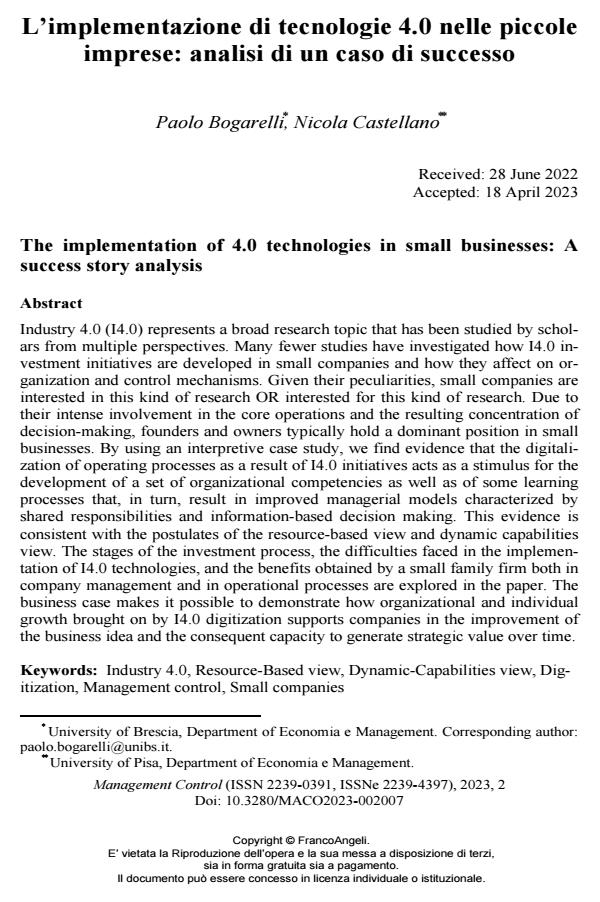L’implementazione di tecnologie 4.0 nelle piccole imprese: analisi di un caso di successo
Titolo Rivista MANAGEMENT CONTROL
Autori/Curatori Paolo Bogarelli, Nicola Castellano
Anno di pubblicazione 2023 Fascicolo 2023/2
Lingua Italiano Numero pagine 28 P. 137-164 Dimensione file 775 KB
DOI 10.3280/MACO2023-002007
Il DOI è il codice a barre della proprietà intellettuale: per saperne di più
clicca qui
Qui sotto puoi vedere in anteprima la prima pagina di questo articolo.
Se questo articolo ti interessa, lo puoi acquistare (e scaricare in formato pdf) seguendo le facili indicazioni per acquistare il download credit. Acquista Download Credits per scaricare questo Articolo in formato PDF

FrancoAngeli è membro della Publishers International Linking Association, Inc (PILA)associazione indipendente e non profit per facilitare (attraverso i servizi tecnologici implementati da CrossRef.org) l’accesso degli studiosi ai contenuti digitali nelle pubblicazioni professionali e scientifiche
Industry 4.0 (I4.0) represents a broad research topic that has been studied by scholars from multiple perspectives. Many fewer studies have investigated how I4.0 investment initiatives are developed in small companies and how they affect on organization and control mechanisms. Given their peculiarities, small compa-nies are interested in this kind of research OR interested for this kind of research. Due to their intense involvement in the core operations and the resulting concen-tration of decision-making, founders and owners typically hold a dominant posi-tion in small businesses. By using an interpretive case study, we find evidence that the digitalization of operating processes as a result of I4.0 initiatives acts as a stimulus for the development of a set of organizational competencies as well as of some learning processes that, in turn, result in improved managerial models char-acterized by shared responsibilities and information-based decision making. This evidence is consistent with the postulates of the resource-based view and dynamic capabilities view. The stages of the investment process, the difficulties faced in the implementation of I4.0 technologies, and the benefits obtained by a small family firm both in company management and in operational processes are explored in the paper. The business case makes it possible to demonstrate how organizational and individual growth brought on by I4.0 digitization supports companies in the improvement of the business idea and the consequent capacity to generate strate-gic value over time.
Parole chiave:Industry 4.0, Resource-Based view, Dynamic-Capabilities view, Digit-ization, Management control, Small companies
- Exploring the role of digital platforms in promoting value co-creation: evidence from the Italian municipal solid waste management system Luigi Mersico, Selena Aureli, Eleonora Foschi, in Sustainability Accounting, Management and Policy Journal /2025
DOI: 10.1108/SAMPJ-03-2024-0317
Paolo Bogarelli, Nicola Castellano, L’implementazione di tecnologie 4.0 nelle piccole imprese: analisi di un caso di successo in "MANAGEMENT CONTROL" 2/2023, pp 137-164, DOI: 10.3280/MACO2023-002007